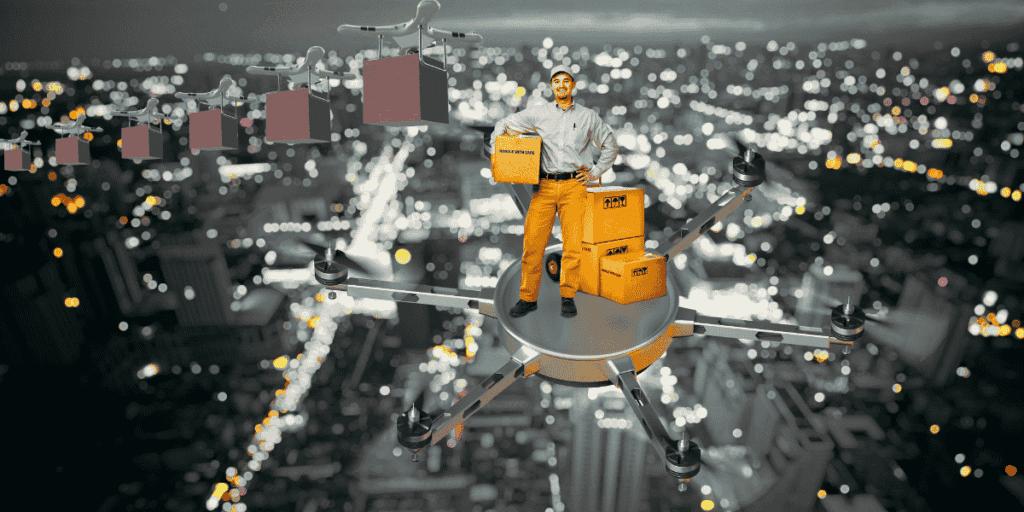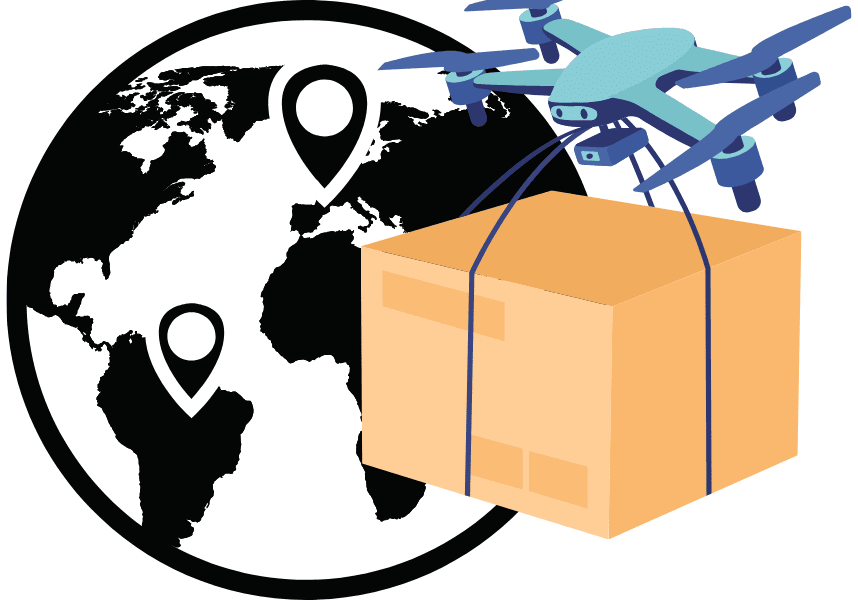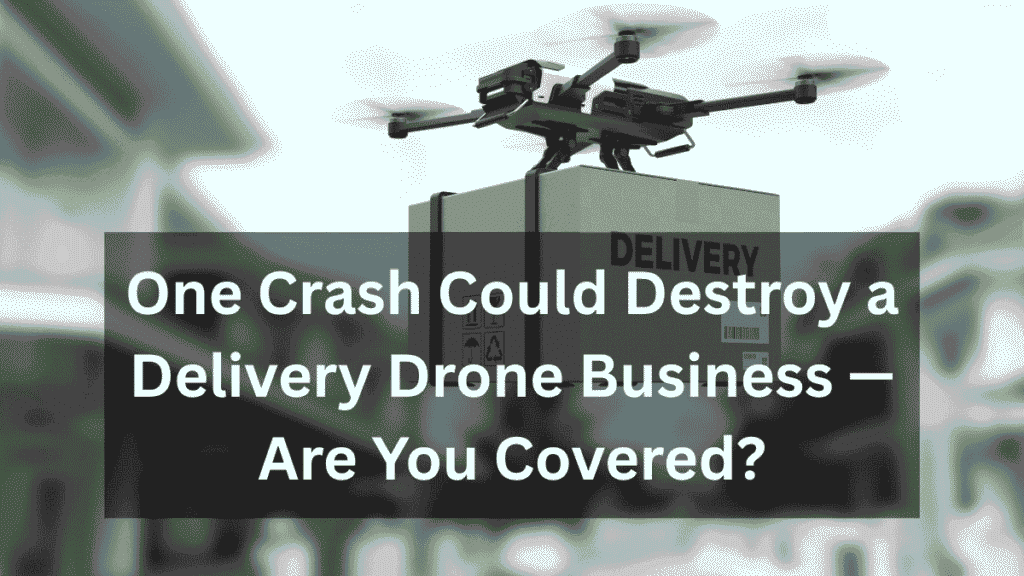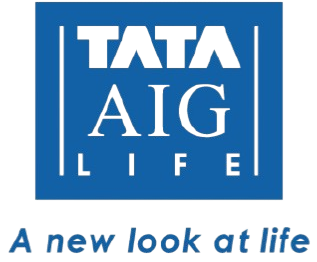As companies like Amazon, Zomato and Ecom Express leverage drones for last-mile deliveries, the need for drone insurance for delivery services in India has become critical. This specialized insurance protects businesses from financial risks associated with drone operations, ensuring compliance with regulations and safeguarding assets.
Drone insurance in India is transforming e-commerce and logistics with faster, more efficient delivery systems. This comprehensive guide explores e-commerce drone insurance and drone logistics insurance, detailing the best policies, coverage options, costs and considerations for businesses in India’s rapidly evolving drone ecosystem.
Rise of Drone Delivery System in India

Drones or Unmanned Aerial Vehicles (UAVs), are revolutionizing logistics by enabling rapid deliveries to urban and remote areas. According to a 2024 Business Standard report, drones are expected to handle 30% of quick commerce deliveries in major Indian cities by 2027, reducing operating costs by 40–70% compared to traditional vehicle deliveries.
Companies like Skye Air, TechEagle and Garuda Aerospace are pioneering drone-based logistics, with trials already handling thousands of daily deliveries in cities like Gurgaon. However, with this growth comes risks—accidents, theft, or third-party damages—that necessitate robust drone insurance for delivery services in India.
Here’s a rewritten, fully expanded version of your article, developed into a detailed 1000+ word piece:
Why Drone Insurance is Essential for Delivery Services
In recent years, drones have rapidly evolved from recreational gadgets into powerful commercial tools. From aerial photography and surveying to agriculture and logistics, drones are revolutionizing industries worldwide. One of the most transformative applications is in delivery services, where drones promise faster, cheaper, and more efficient transportation of goods.
However, with this innovation comes new challenges. Drones are not just flying cameras or toys—they are aircraft, and like any aircraft, they are subject to risks such as crashes, equipment failures, or collisions. These risks make drone insurance not just optional, but essential for businesses that want to scale delivery operations responsibly and sustainably.
In India, where the drone ecosystem is expanding rapidly, the government has already recognized the importance of regulating drone usage. Under the Drone Rules 2021, the Directorate General of Civil Aviation (DGCA) has laid down clear requirements, including mandatory insurance. But beyond compliance, insurance offers financial security, operational confidence, and contributes to the broader growth of the drone market.
Let’s take a closer look at why drone insurance is indispensable for delivery services.
1. Regulatory Compliance: Meeting Legal Requirements
The Indian drone industry is governed by the Drone Rules 2021, a progressive framework aimed at balancing innovation with safety. One of the key stipulations is found in Rule 44, which requires third-party liability insurance for all commercial drone operators.
This means that any business using drones for delivery services—whether for e-commerce packages, medical supplies, or groceries—must ensure that their drones are insured. The intent behind this regulation is clear: in the event of an accident, injury, or property damage caused by a drone, there must be a mechanism for compensation.
Non-compliance carries significant consequences. Operators without valid insurance risk:
- Heavy fines and penalties.
- Possible suspension of operating licenses.
- Legal liabilities in case of accidents.
For businesses looking to build credibility and longevity in the drone delivery sector, compliance is non-negotiable. By securing proper insurance, companies not only adhere to the law but also demonstrate a commitment to responsible and ethical operations.
2. Financial Protection: Safeguarding Against Unforeseen Risks
Operating drones for delivery is not without risk. Unlike traditional ground vehicles, drones fly in complex environments where hazards abound. They may collide with birds, trees, or buildings, malfunction due to technical issues, or even be hijacked digitally through cyberattacks.
Each of these scenarios can lead to costly outcomes, including:
- Drone repairs or replacements – High-quality drones with payload capacity can cost lakhs of rupees. A single accident could wipe out a company’s investment.
- Damage to third-party property – For example, if a drone crashes onto a parked car or building.
- Injury to people – A malfunctioning drone falling in a crowded area could cause serious harm, triggering expensive compensation claims.
- Legal disputes – Accidents often lead to lawsuits, which can be financially draining without insurance coverage.
Drone insurance cushions businesses from such risks by covering these liabilities. Instead of bearing sudden, unpredictable costs, companies can focus on growth while knowing they are financially protected.
For small and medium-sized enterprises (SMEs) entering the drone delivery space, this protection is even more critical. A single uninsured accident could potentially shut down an entire operation. Insurance transforms risk into a manageable business cost, making it a smart financial strategy.
3. Operational Confidence: Building Trust with Clients and Partners
Trust is the foundation of any business, and in an emerging field like drone deliveries, trust is earned through professionalism, transparency, and safety. Insurance plays a direct role in this process.
When businesses insure their drones, they send a clear message to clients, partners, and stakeholders:
- Reliability – Clients know that even if something goes wrong, operations are backed by financial protection.
- Professionalism – Insurance shows that the business takes regulations and responsibilities seriously.
- Risk management – Partners are reassured that they will not be exposed to liability due to the company’s operations.
For example, large e-commerce firms, hospitals, or logistics providers are more likely to partner with drone delivery companies that are insured. Insurance coverage becomes a competitive differentiator, helping businesses win contracts and expand their networks.
Furthermore, having insurance boosts internal confidence as well. Drone operators and employees feel more secure knowing that they are covered against unforeseen accidents. This peace of mind translates into smoother operations and better customer service.
4. Market Growth: Supporting India’s Drone Economy
India has ambitious plans to become a global drone hub by 2030. The government is actively promoting the industry through policy reforms, subsidies, and initiatives like the Production Linked Incentive (PLI) scheme.
The drone market in India is projected to reach ₹50,000 crore in the next five years, with delivery services being one of the largest contributors to this growth. From last-mile e-commerce to emergency medical supply transport, drones are set to play a crucial role in the logistics ecosystem.
But for this growth to be sustainable, safety and trust are paramount. No market can thrive if accidents are frequent and liabilities remain unresolved. This is where insurance acts as a cornerstone of growth. By mitigating risks and ensuring smooth compensation mechanisms, insurance strengthens confidence in drone technology.
Moreover, international investors and partners often view insurance as a marker of maturity in an emerging sector. Widespread adoption of drone insurance in India will therefore make the industry more attractive to global collaborations and funding.
5. Beyond Delivery: The Future Role of Drone Insurance
While delivery services are the most visible application of drones, insurance will soon become integral across all sectors where drones operate. Whether it’s agriculture, infrastructure monitoring, disaster management, or filmmaking, every drone carries some degree of risk.
As the ecosystem grows, insurance products themselves will evolve. We are likely to see specialized policies covering:
- Cybersecurity risks (hacking of drones).
- Payload insurance (covering valuable goods being delivered).
- Business interruption insurance (covering losses due to downtime from drone failures).
For delivery companies, these advancements mean greater flexibility and protection tailored to their needs. Far from being a mere regulatory requirement, drone insurance will become a strategic enabler of innovation.
Types of Drone Insurance for Delivery Services in India
Drone logistics insurance encompasses various coverage types tailored to the unique risks of e-commerce and logistics operations. Here’s a breakdown of the key coverage options:
- Third-Party Liability Insurance (Mandatory):
- Covers damages or injuries caused by drones to third parties, such as property damage or bodily injury.
- Essential for compliance with DGCA regulations.
- Hull Coverage:
- Protects the drone itself from physical damage, theft, or loss, critical for expensive delivery drones.
- Payload Coverage:
- Covers goods carried by the drone, such as packages or medical supplies, ensuring compensation for loss or damage.
- Personal Accident Coverage:
- Provides financial protection for injuries or disabilities sustained by the drone operator.
- Add-On Covers:
- Beyond Visual Line of Sight (BVLOS): For drones operating beyond the pilot’s direct view, common in long-distance deliveries.
- Transit Coverage: Protects drones during transportation or storage.
- Night Flying Coverage: Covers operations after sunset, increasingly relevant for 24/7 delivery services.
- Cyber Liability: Addresses risks from data breaches, crucial for drones collecting sensitive delivery data.
- Invasion of Privacy: Covers unintentional privacy violations during drone operations.
Key Coverage Types for Drone Logistics Insurance
| Coverage Type | Description | Relevance for Delivery Services |
|---|---|---|
| Third-Party Liability | Covers third-party property damage or bodily injury | Mandatory for DGCA compliance |
| Hull Coverage | Protects drone from damage, theft, or loss | Protects costly delivery drones |
| Payload Coverage | Covers loss or damage to goods being delivered | Critical for e-commerce packages |
| Personal Accident | Covers operator injuries or disabilities | Enhances operator safety |
| BVLOS Add-On | Covers operations beyond visual line of sight | Enables long-distance deliveries |
| Transit Coverage | Protects drones during transport or storage | Safeguards drones in transit |
| Night Flying Coverage | Covers operations after sunset | Supports 24/7 delivery services |
| Cyber Liability | Covers data breach-related liabilities | Protects sensitive delivery data |
Leading Drone Insurance Providers in India
Several insurers offer tailored e-commerce drone insurance and drone logistics insurance policies, with flexible options for delivery services. Below, we compare three leading providers: Tata AIG, HDFC Ergo, and IFFCO Tokio, focusing on their offerings for e-commerce and logistics.
Tata AIG Drone Insurance
- Overview: Tata AIG, in collaboration with the Drone Federation of India (DFI), offers comprehensive drone insurance tailored for commercial operators, including delivery services. Their policies support advanced operations like BVLOS, making them ideal for e-commerce logistics.
- Coverage:
- Hull coverage for drone damage or theft.
- Third-party liability for property damage or bodily injury.
- Add-ons: BVLOS, night flying, data loss liability.
- Key Features:
- Industry-specific solutions developed with DFI.
- Flexible add-ons for delivery operations.
- Available through platforms like TropoGo.
- Best For: Businesses with frequent drone deliveries or high-value drones.
HDFC Ergo Drone Insurance
- Overview: HDFC Ergo pioneered drone insurance in India in 2019, partnering with TropoGo to offer a “pay as you fly” model, perfect for e-commerce companies with variable delivery schedules.
- Coverage:
- Third-party liability (up to ₹10,00,000).
- No hull coverage, focusing solely on liability.
- Key Features:
- Flexible, per-flight insurance reduces costs for occasional deliveries.
- Easy online purchase via TropoGo.
- DGCA-compliant for commercial operations.
- Best For: Startups or businesses with sporadic drone usage.
IFFCO Tokio Drone Rakshak Insurance
- Overview: IFFCO Tokio’s Drone Rakshak Insurance offers comprehensive coverage, including unique personal safety features, making it suitable for logistics operators prioritizing operator protection.
- Coverage:
- Hull coverage with a 5% deductible (minimum ₹2,500).
- Third-party liability, including defense costs.
- Personal accident coverage (up to 125% of Sum Assured for disability).
- Medical expenses for operator injuries (up to Sum Insured).
- Add-ons: Cyber liability, invasion of privacy, alternate hire charges, transit coverage.
- Key Features:
- Broad coverage, including personal safety.
- High claim settlement ratio (95.82% in FY2021 for general insurance).
- Customizable add-ons for delivery-specific risks.
- Best For: Enterprises needing all-round protection for drones and operators.
Comparison of Drone Insurance Providers for Delivery Services
| Feature | Tata AIG | HDFC Ergo | IFFCO Tokio |
|---|---|---|---|
| Hull Coverage | Yes | No | Yes (5% deductible) |
| Third-Party Liability | Yes | Yes (₹10,00,000 limit) | Yes |
| Personal Accident | No | No | Yes |
| Payload Coverage | Optional | No | Optional |
| BVLOS Add-On | Yes | No | Yes |
| Night Flying Add-On | Yes | No | Yes |
| Premium Range (Annual) | ₹4,000+ | ₹5,000–₹20,000 (or per-flight) | ₹4,000+ |
| Best For | Frequent deliveries, high-value drones | Occasional deliveries | Comprehensive protection |
Sources: Tata AIG, HDFC Ergo, IFFCO Tokio
Also Read : Best Drone Insurance Companies In India
Cost of Drone Insurance for Delivery Services
The cost of drone insurance for delivery in India varies based on factors like drone type, usage frequency, coverage limits and insurer policies. Here’s a breakdown of typical costs as of 2025:
- Third-Party Liability: ₹5,000–₹20,000 annually, or per-flight rates for HDFC Ergo’s “pay as you fly” model.
- Comprehensive Coverage (Hull + Liability): ₹7,000–₹30,000 annually, depending on drone value and add-ons.
- Personal Accident Coverage: ₹500–₹2,000 annually.
- Payload Coverage: Varies based on cargo value, typically ₹1,000–₹5,000 annually.
- Add-Ons (e.g., BVLOS, Night Flying): ₹1,000–₹10,000 annually, depending on risk profile.
Estimated Drone Insurance Costs for Delivery Services
| Coverage Type | Annual Premium Range | Factors Affecting Cost |
|---|---|---|
| Third-Party Liability | ₹5,000–₹20,000 | Drone weight, usage frequency, coverage limit |
| Comprehensive (Hull + Liability) | ₹7,000–₹30,000 | Drone value, add-ons, operational risks |
| Personal Accident | ₹500–₹2,000 | Operator risk profile |
| Payload Coverage | ₹1,000–₹5,000 | Cargo value, delivery type |
| BVLOS/Night Flying Add-Ons | ₹1,000–₹10,000 | Operational complexity, regulatory compliance |
Source: TropoGo
If You want to save money on Drone Insurance see- How To Save Money On Drone Insurance In India?
Regulatory Framework for Drone Delivery Insurance
The DGCA’s Drone Rules 2021 and the Draft Unmanned Aircraft System (UAS) Rules 2020 set the regulatory framework for drone operations in India, particularly for delivery services:
- Mandatory Third-Party Liability: Required for all drones over 250 grams used commercially, covering third-party property damage or bodily injury.
- BVLOS Operations: Recent guidelines allow BVLOS operations with specific permits, necessitating additional insurance coverage.
- Drone Ports: The Draft UAS Rules introduce drone ports for takeoff and landing, increasing the need for transit and payload coverage.
- Compliance: Operators must register drones with a Unique Identification Number (UIN) and adhere to the Motor Vehicle Act of 1988 for third-party liability compensation.
Choosing the Right Drone Insurance for E-Commerce and Logistics
Selecting the right e-commerce drone insurance or drone logistics insurance depends on several factors:
- Usage Frequency:
- Frequent deliveries (e.g., daily e-commerce operations): Opt for Tata AIG or IFFCO Tokio for comprehensive coverage.
- Occasional deliveries (e.g., seasonal campaigns): HDFC Ergo’s “pay as you fly” model is cost-effective.
- Drone Value:
- High-value drones (₹1 lakh+): Prioritize hull coverage from Tata AIG or IFFCO Tokio.
- Budget drones: Focus on mandatory third-party liability.
- Operational Scope:
- BVLOS or night deliveries: Ensure add-ons for these operations.
- Urban vs. rural deliveries: Urban areas may require higher liability limits due to population density.
- Budget:
- Balance comprehensive coverage with cost, using platforms like TropoGo to compare quotes.
Case Study Example:
- Scenario: An e-commerce startup in Gurgaon uses drones for same-day delivery of electronics, requiring BVLOS operations.
- Tata AIG: Offers comprehensive coverage with BVLOS add-ons, ideal for frequent deliveries.
- HDFC Ergo: Suitable for occasional flights but lacks hull coverage.
- IFFCO Tokio: Provides hull, liability, and payload coverage, plus personal accident protection, making it a strong choice for operator safety.
How to Buy Drone Insurance in India?
Buying drone insurance is now streamlined for commercial drone operators. Here’s a step-by-step breakdown:
1. Register Your Drone: Must have a Unique Identification Number (UIN).
2. Obtain Operator Permits: Required for certain categories and payloads.
3. Risk Profiling: Share operational details like delivery routes, payload types, and flight hours.
4. Choose a Policy: Pick from third-party only or full-stack insurance.
5. Documentation: Submit drone invoice, pilot license, flight plan, and risk assessment.
6. Pay and Activate: Pay the premium and receive the insurance certificate.
Challenges and Considerations
While drone insurance for delivery in India is essential, businesses face several challenges:
- Evolving Regulations: The regulatory landscape is still developing, requiring operators to stay updated on DGCA guidelines.
- Data Security: Drones collecting delivery data face cyber risks, necessitating cyber liability coverage.
- Public Perception: Privacy concerns may lead to legal liabilities, requiring invasion of privacy add-ons.
- Technological Risks: Drone malfunctions or collisions require robust hull and payload coverage.
Future of Drone Insurance in India’s E-Commerce and Logistics

The drone delivery market is poised for significant growth, with companies like Skye Air aiming to handle 10,000 daily deliveries by late 2025. Insurance providers are adapting by offering:
- Granular Coverage: Policies tailored to specific risks, such as advanced collision avoidance systems.
- Integration with Technology: Real-time data analytics for risk assessment and claims management.
- Regulatory Alignment: Policies evolving to meet new DGCA standards, such as expanded BVLOS permissions.
Source: Business Standard
FAQs on Drone Insurance for Delivery Services in India
Q.1: Is drone insurance mandatory for e-commerce delivery in India?
Ans. Yes, third-party liability insurance is mandatory for all commercial drone operations, including e-commerce deliveries, as per Rule 44 of the Drone Rules 2021 issued by the DGCA.
Q.2: What does e-commerce drone insurance typically cover?
Ans. E-commerce drone insurance usually includes:
- Third-party liability
- Hull damage (to the drone itself)
- Payload coverage (for goods being delivered)
- Optional add-ons like:
- BVLOS (Beyond Visual Line of Sight)
- Night operations
- Cyber liability protection
Q.3: How much does drone logistics insurance cost in India?
Ans. Annual premiums typically range from:
- ₹5,000–₹20,000 for third-party liability
- ₹7,000–₹30,000 for comprehensive coverage
Pricing depends on factors like drone value, operational area, and frequency of use.
Q.3: Can I get insurance for BVLOS delivery operations?
Ans. Yes. Insurers like Tata AIG and IFFCO Tokio offer BVLOS-specific add-ons for drone operators engaged in long-distance or beyond-visual-line-of-sight deliveries.
Q.4: Does drone insurance cover lost or damaged packages during delivery?
Ans. Yes, if you opt for payload coverage. Providers such as IFFCO Tokio and Tata AIG include protection for lost or damaged goods during flight as part of their comprehensive delivery drone insurance plans.
Q.5: Are there flexible insurance options for occasional or low-volume deliveries?
Ans. Yes. HDFC Ergo offers a “pay as you fly” insurance model, allowing coverage for specific flight hours or missions — ideal for occasional or freelance drone delivery pilots.
Q.6: What are common exclusions in drone insurance policies?
Ans. Common exclusions include:
- Intentional damage or misuse
- Flying in restricted zones
- Violation of DGCA norms
- Using drones without proper permits or UIN
Q.7: How can I purchase drone insurance for delivery services in India?
Ans. You can buy drone insurance:
- Online through platforms like TropoGo
- Directly from insurers such as Tata AIG, HDFC Ergo, and IFFCO Tokio
These platforms often allow policy customization, digital documentation, and instant quotes.
Conclusion
Drone insurance for delivery services in India is rapidly emerging as an indispensable requirement for e-commerce companies, logistics providers, and technology startups that are leveraging drones to revolutionize last-mile delivery. As the Indian drone ecosystem continues to mature, drones are being increasingly used to deliver parcels, groceries, food, medical supplies, and essential items across both urban and rural landscapes. This shift toward drone-based logistics is not just a trend—it’s a strategic move aimed at achieving faster, safer, and more cost-effective deliveries in a highly competitive market.
With the drone delivery market projected to grow exponentially by 2030, insurance has become more than just a regulatory formality. It is now a business-critical tool that offers financial protection, legal compliance, and peace of mind. From accidental damage and equipment theft to third-party liability and payload loss, drone insurance helps businesses mitigate a wide range of risks associated with commercial drone operations.
Leading insurers in India—such as Tata AIG, HDFC ERGO, and IFFCO Tokio—have stepped up to offer customized solutions in the form of e-commerce drone insurance and drone logistics insurance. These policies are specifically designed to meet the unique needs of businesses using drones for delivery purposes. Whether you’re operating a fleet of drones for daily e-commerce shipments or running occasional BVLOS (Beyond Visual Line of Sight) missions in remote areas, there’s a policy that can be tailored to your risk profile and usage frequency.
Options range from comprehensive year-round coverage, which includes hull damage, third-party liability, cyber risk, and payload protection, to short-term and project-based insurance plans suitable for temporary operations or pilot programs. By selecting the right insurance coverage, businesses not only ensure compliance with DGCA regulations but also safeguard their investment and brand reputation. In today’s fast-evolving logistics environment, drone insurance is not just recommended—it’s essential for growth, continuity, and operational confidence.




